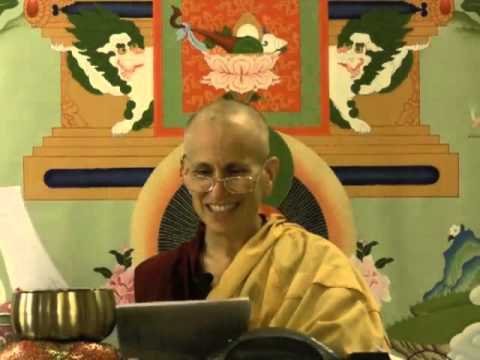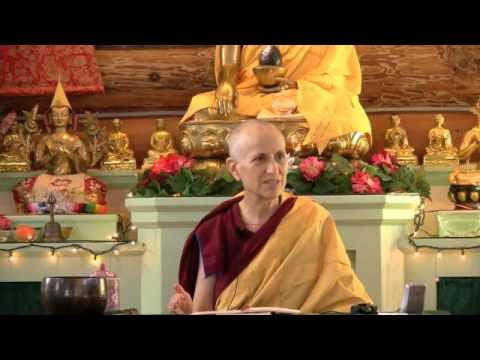Lamrim meditation and the sadhana
This talk was given during the White Tara Winter Retreat at Sravasti Abbey.
- The importance of including analytical meditation as part of the sadhana
- How analytical meditation leads to understanding the Dharma
White Tara Retreat 37: Lamrim meditation (download)
We are at the part where the Buddha just dissolved into us after the meditation. This is the time when you can do the lamrim meditation. You can also do the lamrim right before the Buddha dissolves into you. Either time is okay. By Buddha I mean Tara. Some people like to do it when Tara is still on their head—to do the lamrim meditation then because you can kind of feel like Tara is talking to you.
When you contemplate the lamrim, one good way to do it is to pretend like you are giving an explanation of it to your friend; because then in your mind you are explaining the different points, and if you are going to explain it to a friend you want to give some examples. So you start reflecting on it from your own life, in terms of your own life, and think of some examples. Of course, if you are going to actually talk to a friend about the lamrim you are not going to tell so many personal details of your own life, so that part is going on in your own mind. The idea is the same when you are doing the lamrim that you are really applying the teachings to your life and really contemplating it.
The lamrim means “the gradual path.” A better translation is “the stages of the path to enlightenment.” So you are meditating one by one on each of these different stages and familiarizing yourself with it. His Holiness the Dalai Lama said that this kind of analytic meditation, where you are contemplating many topics, is very important for us because that is what actually brings some understanding for what the Dharma is all about. Understanding the lamrim, the stages of the path, is what is going to make the visualization and mantra recitation practice something meaningful. It is very important here to include this meditation.
We have meditation outlines that people can follow. Or you can make your own outline based on the reading that you have been doing. If you are reading some book about the Dharma then you make an outline of the important topics and meditate on that. It is good to know the whole general outline of the lamrim topics so that you know where a specific teaching fits in. Otherwise, if you don’t know that complete overview then you read this and that, but none of it makes sense because you don’t know where it fits in together in the practice of one person as you go along. So that is why I really suggest having a whole understanding of the overview and the outline of the entire lamrim and familiarizing yourself with all the meditations. That is very helpful. Otherwise you hear something and it is like, “Well, do I practice that? But last weekend I heard this teaching and next week I am going to another place and I am going to hear that teaching. Which one do I practice and how do they all go together?” You get quite confused.
If you understand the stages of the path and really spend some time learning it and contemplating the different stages then it really makes a lot of sense and it is tremendously helpful. I know that when I first went to Singapore years ago people were so confused about this kind of thing. They were saying, “Should we do Amitaba meditation? Then somebody else taught us to do mindfulness. Then this other teacher was here and taught us the meditation of love. What do I practice? How does it all fit together?” This is where the lamrim is very helpful for knowing how to construct a cohesive practice for yourself. You meditate at a level that corresponds to your capacity. Otherwise you are in fifth grade and you are doing a high school text and you are wondering why it is hard.
If you do the lamrim with Tara on your head then you think that Tara is kind of guiding you through it. If you prefer for Tara to dissolve in you and then reappear at your heart, you can feel that Tara is there in your heart, kind of watching over you as you are doing the meditation, and bringing her inspiration and blessings to your mind.
Venerable Thubten Chodron
Venerable Chodron emphasizes the practical application of Buddha’s teachings in our daily lives and is especially skilled at explaining them in ways easily understood and practiced by Westerners. She is well known for her warm, humorous, and lucid teachings. She was ordained as a Buddhist nun in 1977 by Kyabje Ling Rinpoche in Dharamsala, India, and in 1986 she received bhikshuni (full) ordination in Taiwan. Read her full bio.


